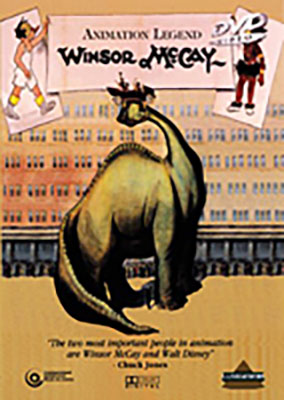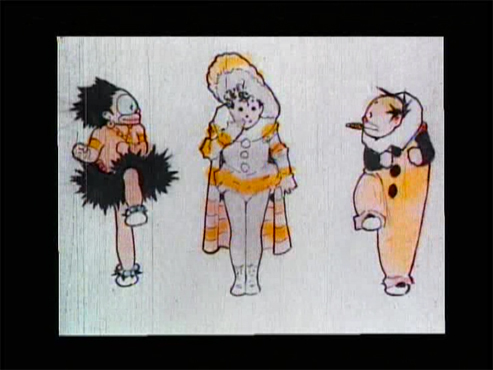
Reviews of silent film releases on home video.
Copyright © 1999-2024 by Carl Bennett
and the Silent Era Company.
All Rights Reserved. |
|
Animation Legend:
Winsor McCay
(1911-1921)
|
Contents: Winsor McCay and His Moving Comics (1911), How a Mosquito Operates (1912), Gertie the Trained Dinosaur (1914), The Sinking of the Lusitania (1918), The Centaurs (circa 1918-1921), Gertie on Tour (circa 1918-1921), Flip’s Circus (circa 1918-1921), Bug Vaudeville (1921), The Pet (1921) and The Flying House (1921).
To those who know his work, Winsor McCay represents the pinnacle in early 20th century newspaper comics illustrators. McCay’s superlative command of detail and perspective combined with his fantastical imagination made him one of the most popular illustrators of his time and one of the most influential of this century’s artists. McCay also became a successful live performer, drawing amusing ‘lightning sketches’ with chalk on blackboard in just a few moments before vaudeville audiences. With this collection of animation works, modern audiences can rediscover another aspect of Winsor McCay — the pioneering master of animation.
Inspired by small advertising flip books brought to his attention by his son, Winsor McCay began experimenting with applying animation to motion pictures. For nearly a year McCay worked around his newspaper reponsibilities and his vaudeville obligations, producing the sequential drawings that would make up his first animated film Winsor McCay and His Moving Comics (1911) [also known as Little Nemo]. The animation section was bracketed by live-action footage of McCay, fellow cartoonist George McManus and Vitagraph comedy star John Bunny. McCay wagers that he can, in one month, make drawings that will move. His friends think he is crazy. McCay’s month is up (compressed from the real-life year) and shows the results of his work to his friends. Characters from McCay’s popular weekly strip, Little Nemo in Slumberland, then tumble and cavort on-screen in America’s first sustained animated film.
McCay’s second film, How a Mosquito Operates (1912), follows the attack of the persistent mosquito on a sleeping man. It is the first of McCay’s animated films that attempts a story narrative and characterization.
McCay’s best known film was Gertie the Trained Dinosaur (1914). Originally conceived as a part of his vaudeville act, Winsor McCay created an animated film that would allow him, on stage, to interact with the cartoon dinosaur being projected on the screen. Gertie was among the first cartoon characters with a distinctive personality, being at turns shy, distracted, extroverted and stubborn.
The Sinking of the Lusitania (1918) is one of animation’s finest achievements ever and is, undeniably, the first animated masterpiece. McCay produced his most ambitious and most impressive film of his career in this narrative accounting of the event that precipitated the beginning of World War I. The film is undeniably propaganda, with its decidedly anti-German position intended to bolster continued support for the Allied cause. It is also an emotional dramatic film, playing heavily on the sympathetic heartstrings of the audience. Its level of artistic and narrative realism had never been achieved before and would not be matched (even in McCay’s later works) for many years to come. We are very impressed with this animation of the billows of smoke coming from the dying Lusitania, blowing in the sea winds, and in the animation of the people leaping from the sinking stern of the boat.
On one hand it is a shame that this masterpiece has not survived in better condition, on the other hand the fact that it has survived at all is a blessing on modern audiences, who may still have the opportunity to experience this crowning achievement.
The three films that followed may have been nothing more than experiments, and certainly two of them survive as nothing more than fragments. The Centaurs (circa 1918-1921) is a brief pastoral visit with an extended family of centaurs. Gertie on Tour (circa 1918-1921) may have been an aborted attempt to recapture the past success of the previous Gertie film. Of the three films here that did not make it into distribution, Flip’s Circus (circa 1918-1921) appears to have been the closest to being in a finalized film. The surviving film is apparently a print taken from the original animation camera negative. It includes the animation cameraman’s notes (written in chalk on a small blackboard and photographed as single frames) to the film’s editor. These are notes as to which intertitles are to be inserted where, which intertitles have yet to be written and noting unnecessary animation frames that are to be edited out of the final film.
Bug Vaudeville (1921), The Pet (1921) and The Flying House (1921) are all installments from McCay’s film series adaptation of his popular Dreams of the Rarebit Fiend comic strip. The premise is, as always, that after eating rarebit cheese people will fall alseep and have unusual fantasy dreams.
The surviving prints in Montreal’s La Cinémathèque Québécoise film archive came from a collection of some eight dozen film cans of Winsor McCay films given to Irving Mendelsohn by Robert Winsor McCay, Winsor’s son. The films were stored in Mendelsohn’s Long Island garage for many years, until they were ‘discovered’ by Robert N. Brotherton. Many of the films had decomposed, but Brotherton and Mendelsohn sought out some means to save the remaining films. Eventually La Cinémathèque Québécoise provided the means to rescue and restore the films. We are grateful for this eleventh hour reprieve.
— Carl Bennett
|
 Lumivision Corporation Lumivision Corporation
1997 DVD edition
Animation Legend: Winsor McCay (1911-1921), black & white, 100 minutes total, not rated,
including Winsor McCay and His Moving Comics (1911), black & white, 10 minutes, not rated, How a Mosquito Operates (1912), black & white, 6 minutes, not rated, Gertie the Trained Dinosaur (1914), black & white, 12 minutes, not rated, The Sinking of the Lusitania (1918), black & white, 10 minutes, not rated, The Centaurs (circa 1918-1921), black & white, 3 minutes, not rated, Gertie on Tour (circa 1918-1921), black & white, 2 minutes, not rated, Flip’s Circus (circa 1918-1921), black & white, 8 minutes, not rated, Bug Vaudeville (1921), black & white, 14 minutes, not rated, The Pet (1921), black & white, 13 minutes, not rated, and The Flying House (1921), black & white, 19 minutes, not rated.
Lumivision Corporation, DVD1397, UPC 7-24117-13976-6.
One single-sided, dual-layered, Region 0 NTSC DVD disc, 1.33:1 aspect ratio image in windowboxed 4:3 (720 x 480 pixels) interlaced scan MPEG-2 format, SDR (standard dynamic range), 5.0 Mbps average video bit rate, 384 Kbps audio bit rate, Dolby Digital 48 kHz 2.0 stereo sound, English language intertitles, no foreign language subtitles, 13 chapter stops; standard DVD keepcase; $24.95.
Release date: 30 September 1997.
Country of origin: USA
Ratings (1-10): video: 7 / audio: 7 / additional content: 7 / overall: 7.
|

Starting off this DVD collection is Winsor McCay’s first animated film, Winsor McCay and His Moving Comics (1911) [also known as Little Nemo]. The print used for the video transfer features original hand-coloring during the animation section. The 35mm print is worn but generally in very good shape (with a brief section lost to nitrate film decomposition).
The 35mm print of How a Mosquito Operates (1912) is, again, worn but in very-good condition.
The print of Gertie the Trained Dinosaur (1914) used for the transfer was a version prepared for general cinema release, with intertitles included to replicate McCay’s on-stage vaudeville performance. A live-action prologue was prepared, along the lines of McCay’s first film, to start this version. The video transfer of this film was prepared from the best sections of surviving 35mm and 16mm prints of Gertie.
For the opportunity to own The Sinking of the Lusitania (1918) alone it is worth buying this DVD. The 35mm print from which the transfer was taken is worn but still in very good to good condition.
The 35mm print for The Centaurs (c. 1918-1921) is in very-good to excellent condition, although it is missing one shot that is present in the version included the Library of Congress/Smithsonian Video The Origins of Film series Origins of American Animation collection. The 35mm print transfer of Gertie On Tour (c. 1918-1921) looks better here than the transfer available on the Origins collection. The 35mm print of Flip’s Circus (c. 1918-1921) is in excellent condition.
Bug Vaudeville is taken from a worn but very good 35mm print. The Pet and The Flying House are taken from very good 16mm prints. The 16mm print of The Flying House is over-cropped on all sides and thus loses parts of the word balloons that carry the characters’ dialogue. 35mm fragments of The Flying House are also included on the disc.
All films are presented in ‘windowbox’ format. We totally endorse this method of silent film presentation, since some silent films (particularly those surviving only in 16mm reduction prints) are overcropped on video transfers, cutting off the tops of heads and the sides of intertitles. This allows the total surviving image area to be seen on all televisions, regardless of the amount of your television’s overscan cropping.
The DVD features a very good music score performed on MIDI-based synthesizers. While we are not fans of synthesizer soundtracks for silent films, the Lumivision scores are of better quality than other silent film synthesizer presentations on home video in the late 1990s.
Overall, the DVD (which is identical to Lumivision’s 1993 laserdisc release of this program) is of high-quality and is quite pleasing. This edition has been surpassed by the Milestone remastered DVD that features a larger screen image with no cropping to allow the maximum amount of screen image to be seen.
This Lumivision edition is now out-of-print, but it can occasionally be found used through Amazon, eBay, and other sources. The program has been remastered for DVD and released by Milestone Films.
|
|
USA: Click the logomark to purchase this Region 0 NTSC DVD edition from Amazon.com. Your purchase supports Silent Era.
|

|
|
|
Canada: Click the logomark to purchase this Region 0 NTSC DVD edition from Amazon.ca. Your purchase supports Silent Era.
|

|
|
 SlingShot Entertainment SlingShot Entertainment
1999 DVD edition
Animation Legend: Winsor McCay (1911-1921), black & white, 100 minutes total, not rated,
including Winsor McCay and His Moving Comics (1911), black & white, 10 minutes, not rated, How a Mosquito Operates (1912), black & white, 6 minutes, not rated, Gertie the Trained Dinosaur (1914), black & white, 12 minutes, not rated, The Sinking of the Lusitania (1918), black & white, 10 minutes, not rated, The Centaurs (circa 1918-1921), black & white, 3 minutes, not rated, Gertie on Tour (circa 1918-1921), black & white, 2 minutes, not rated, Flip’s Circus (circa 1918-1921), black & white, 8 minutes, not rated, Bug Vaudeville (1921), black & white, 14 minutes, not rated, The Pet (1921), black & white, 13 minutes, not rated, and The Flying House (1921), black & white, 19 minutes, not rated.
SlingShot Entertainment, DVD9817, unknown UPC number.
One single-sided, dual-layered, Region 1 NTSC DVD disc, 1.33:1 aspect ratio image in windowboxed 4:3 (720 x 480 pixels) interlaced scan MPEG-2 format, SDR (standard dynamic range), ? Mbps average video bit rate, ? Kbps audio bit rate, Dolby Digital 48 kHz 2.0 stereo sound, English language intertitles, no foreign language subtitles, chapter stops; standard DVD keepcase, $19.99.
Release date: 12 January 1999.
Country of origin: USA
Ratings (1-10): video: 7 / audio: 7 / additional content: 7 / overall: 7.
|





































